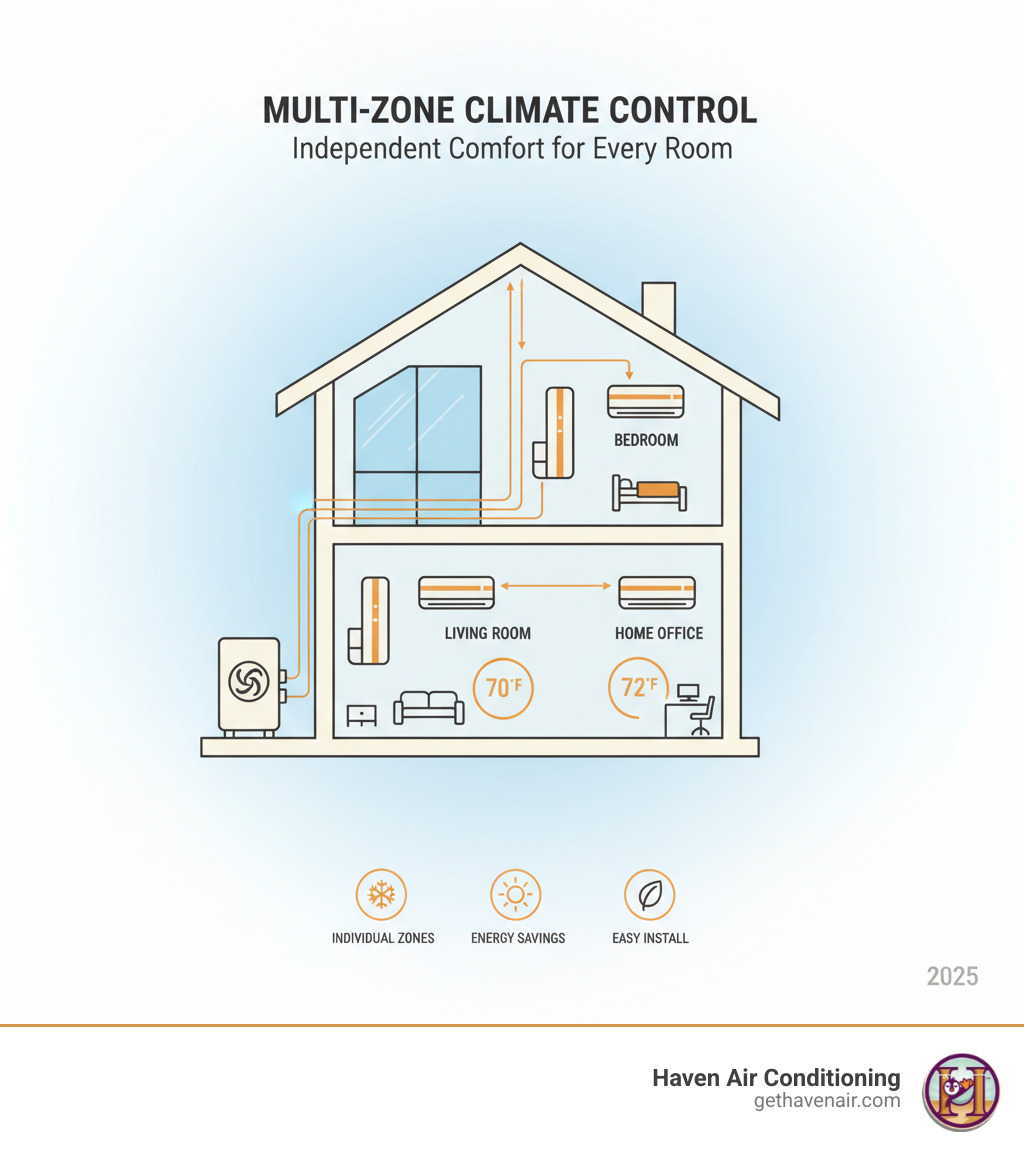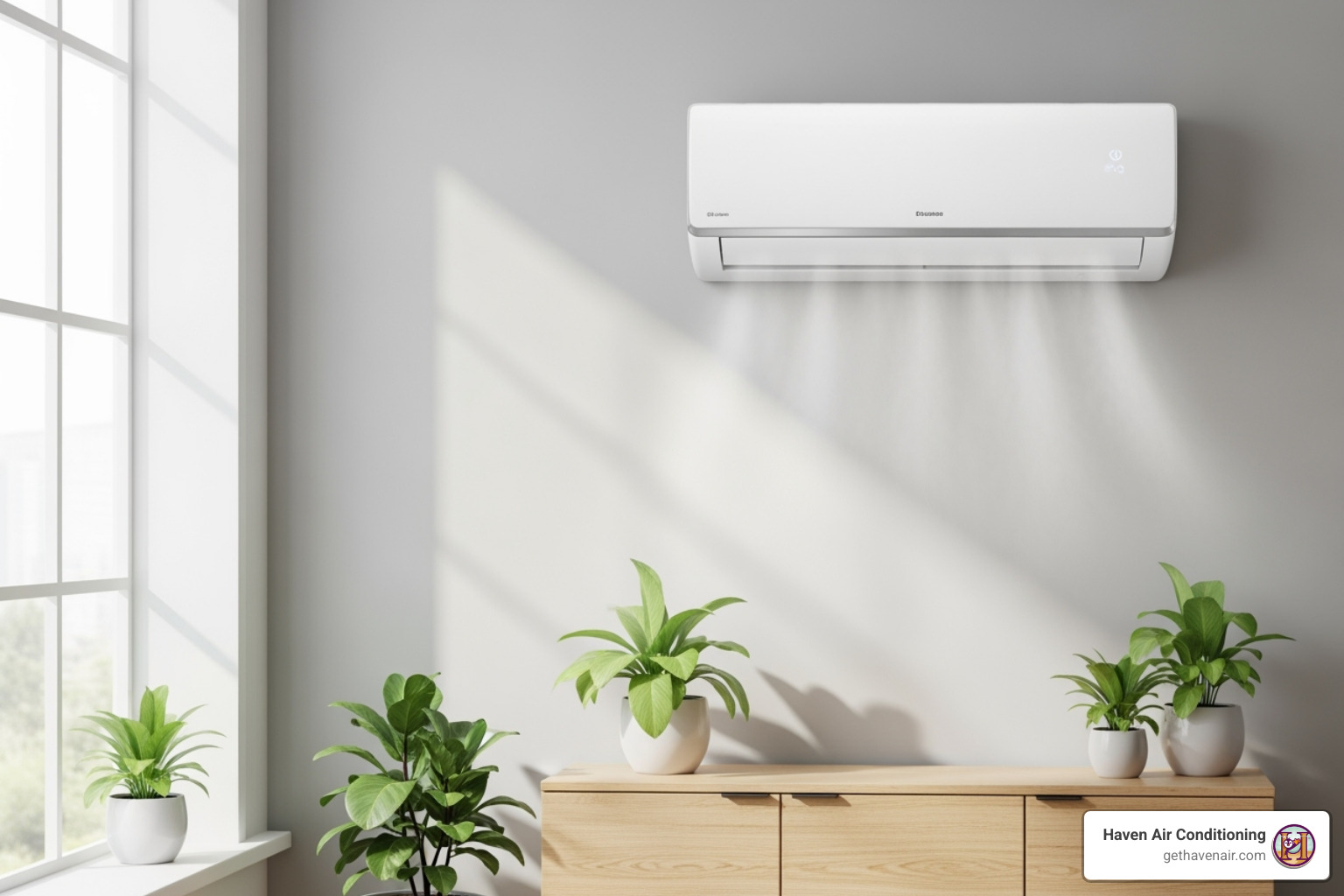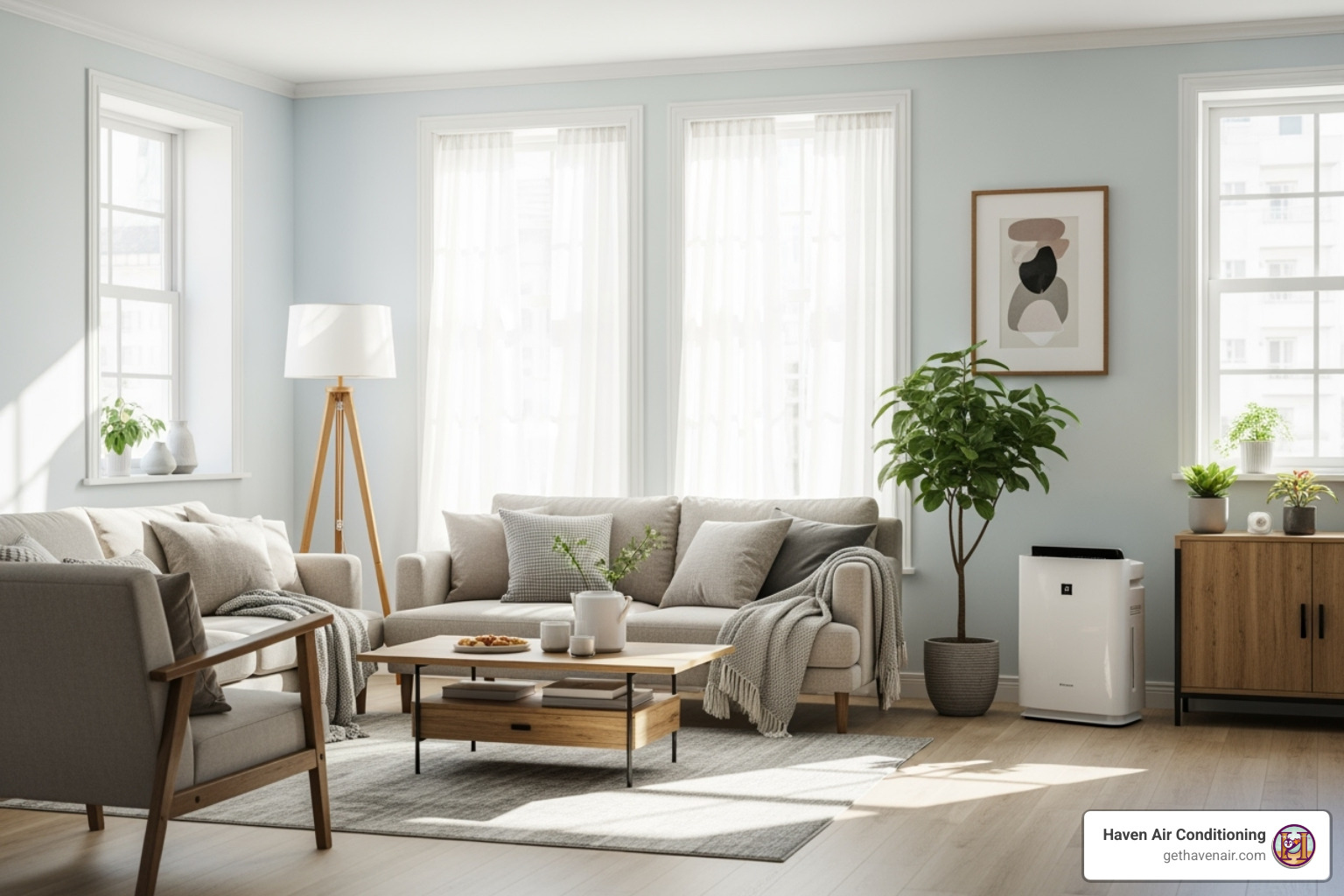Why Multi-Zone Mini Splits Are Changing Home Comfort
A multi zone mini split system is a approach to home climate control that connects a single outdoor unit to multiple indoor units, allowing you to set the temperature in different rooms or “zones” independently. For decades, homeowners have relied on traditional central air systems that treat the entire home as a single zone. This often leads to the classic “thermostat wars,” where one person is freezing while another is sweating, and rooms that are rarely used are heated or cooled unnecessarily. Multi-zone systems eliminate these issues by giving you precise, room-by-room control over your environment.
Key Features of Multi-Zone Mini Splits:
- Single Outdoor Unit: Unlike installing multiple separate systems, a multi-zone setup uses one efficient outdoor condenser to power anywhere from two to eight or more indoor units. This conserves outdoor space and simplifies the overall system architecture.
- Individual Temperature Control: Each indoor unit has its own thermostat, allowing you to create customized climate zones. You can keep your bedroom cool for sleeping, your living room comfortable for relaxing, and turn off the unit in an unused guest room altogether.
- No Ductwork Required: The indoor and outdoor units are connected by small refrigerant lines, not bulky and invasive ductwork. This makes installation far easier, especially in older homes, and eliminates the energy loss and air quality issues associated with traditional ducts.
- Exceptional Energy Efficiency: By only conditioning the rooms you’re actively using, you drastically reduce energy waste. This targeted approach, combined with advanced inverter technology that modulates compressor speed, makes mini splits one of the most efficient ways to heat and cool your home.
- Flexible Installation: The ductless design and variety of indoor unit styles (wall-mounted, ceiling cassettes, etc.) offer incredible flexibility. They can be seamlessly integrated into new construction projects or retrofitted into existing homes with minimal disruption.
Multi-zone systems solve the age-old problem of uneven temperatures throughout your home. Research shows these systems allow for independent temperature regulation in each room, eliminating the discomfort of a one-size-fits-all approach. The technology works by using refrigerant lines to connect indoor air handlers in different rooms to a single outdoor compressor. Each indoor unit can be controlled separately, so your bedroom can be 68°F while your living room stays at 72°F.
Who Benefits Most from a Multi-Zone System?
- Homes with Varying Sun Exposure: If your west-facing living room becomes an oven in the afternoon sun, you can cool it down without turning the rest of your house into an icebox.
- Families with Different Comfort Preferences: End the thermostat battles for good. Parents who prefer a cooler master bedroom can have their ideal temperature, while the kids’ rooms can be kept warmer.
- Properties with Unused Rooms or Areas: Empty nesters or those with guest rooms and home offices can save significant energy by turning off the climate control in those spaces when they’re not occupied.
- Older Homes Without Existing Ductwork: For historic or architecturally unique homes, installing a full duct system can be prohibitively expensive and damaging. A multi-zone mini split provides modern comfort while preserving the home’s character.
With proper maintenance from a certified professional, most multi-zone systems last 15-20 years or more, providing a long-term, reliable solution for customized home comfort. Depending on the model, you can create zone control for up to eight or more separate rooms.
Multi-Zone vs. Single-Zone: A Head-to-Head Comparison
Choosing between a single-zone and multi zone mini split system is one of the biggest decisions you’ll make when upgrading your home’s comfort. Both options deliver impressive efficiency and performance, but they serve very different purposes. Understanding these differences is the key to picking the perfect fit for your home and lifestyle.
Think of a single-zone system as a focused specialist or a precision tool. It pairs one outdoor unit with one indoor unit, making it the perfect solution for a single space. It’s ideal for cooling a new home office, heating a converted garage, or finally taming that one sunroom that’s always too hot or cold. These systems excel in smaller spaces or when you need to add targeted comfort to a specific area without altering your main HVAC system.
The beauty of single-zone systems lies in their simplicity and targeted effectiveness. Installation is relatively straightforward, and they are a cost-effective choice for room additions, workshops, or homes where you only need to solve a single problem area. However, their primary limitation is in their namethey can only condition one space.
A multi zone mini split system takes a completely different approach. It’s a comprehensive, whole-home solution that acts as a central command center for your comfort. It connects one powerful outdoor unit to multiple indoor units (typically two to eight or more) throughout your house. Each room with an indoor unit becomes its own distinct climate zone, complete with independent temperature control.
This flexibility is a true game-changer for household comfort. Your living room can stay at a cool 70 for movie night while your bedroom maintains a cozy 68 for sleepingall controlled separately and running from a single outdoor unit. No more compromising on comfort, leaving doors open to balance temperatures, or paying to heat and cool rooms you aren’t even using.
Scalability is another major advantage of multi-zone systems. You can start with two or three zones and easily add more indoor units later as your family grows or your needs change. Whether you’re dealing with a multi-story home, rooms with drastically different sun exposure, or family members with varying comfort preferences, multi-zone systems adapt to your unique lifestyle.
| Feature | Single-Zone Mini-Split | Multi-Zone Mini-Split |
|---|---|---|
| Coverage | One room or area | Multiple rooms (2-8+ zones) |
| Best For | Room additions, small spaces, targeted comfort | Whole-home solutions, larger properties |
| Installation | Simple, straightforward | More complex, requires professional planning |
| Flexibility | Limited to one area | Highly adaptable, expandable |
| Control | Single thermostat | Independent control for each zone |
Key Advantages of a Multi-Zone System
The real magic of multi zone mini split systems happens when you experience true personalized comfort. Each family member can set their preferred temperature in their own space without affecting anyone else. Imagine a household where the parents, who run warm, can keep the master bedroom cool at night. At the same time, the kids, who get cold easily, can maintain warmer temperatures in their rooms. This level of customization ensures everyone stays comfortable.
Zone control also eliminates those frustrating hot and cold spots that plague so many homes. That sunny living room that gets uncomfortably warm in the afternoon? You can cool it down without freezing out the rest of the house. The basement office that always stays chilly? Warm it up independently without wasting energy on the unoccupied upstairs. This targeted approach puts you in complete control of your environment.
The energy savings are substantial. Instead of conditioning your entire home to a single temperature, you only use energy to heat or cool the rooms you’re actually using. According to the U.S. Department of Energy, duct losses can account for more than 30% of energy consumption for space conditioning. Since mini splits are ductless, you avoid this significant source of energy waste entirely. By turning off units in empty rooms, you can dramatically reduce your monthly energy bills compared to traditional central air systems. For more information on their efficiency, you can review the standards set by ENERGY STAR for ductless heating and cooling.
Since these systems require no ductwork, they’re perfect for older homes, room additions, or any space where installing ducts would be impractical, expensive, or aesthetically disruptive. The small refrigerant lines that connect the indoor and outdoor units are far less invasive than traditional ductwork, preserving the architectural integrity of your home while delivering modern comfort.
For more details on how zone control can transform your comfort, check out our guide on Zone Control Benefits with Mini Split AC.
Installation and Sizing Considerations
While multi-zone systems offer incredible benefits, their flexibility comes with increased complexity during installation. Each indoor unit requires its own dedicated refrigerant line running back to the outdoor unit, along with separate electrical connections and condensate drain lines. This requires careful planning to ensure the lines are run efficiently and discreetly.
This is why professional installation is not just recommendedit’s essential. A certified HVAC technician will perform a proper load calculation (like a Manual J) to ensure the system is sized correctly for your home’s specific needs. An undersized system will struggle to keep up on extreme days, while an oversized system will short-cycle, failing to dehumidify properly and causing unnecessary wear and tear. Proper capacity matching between the outdoor unit and the combined indoor units is critical for efficient operation and longevity.
The placement of each indoor unit also requires careful planning to maximize airflow, efficiency, and comfort. An expert will consider factors like room size, layout, sun exposure, insulation levels, and typical usage patterns to determine the optimal location for each air handler. The outdoor unit must also be placed strategically to ensure proper clearance, minimize noise, and allow for easy maintenance access.
For expert guidance on sizing your system correctly, visit our resource on Proper Sizing for Home AC Split Mini Systems. And to ensure optimal performance, learn about strategic placement in our article about how Ductless AC Placement Maximizes Home Comfort.






